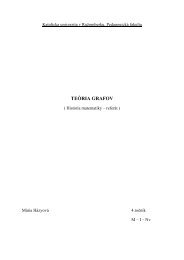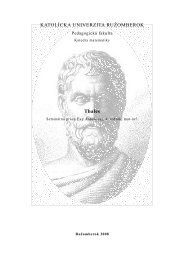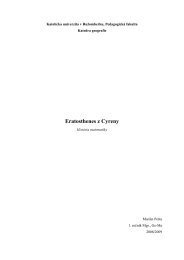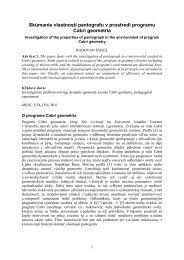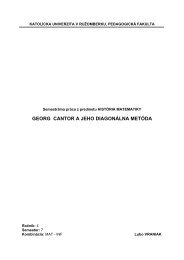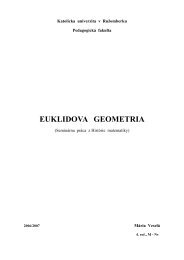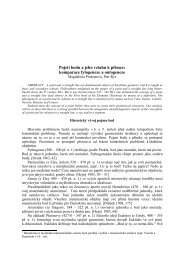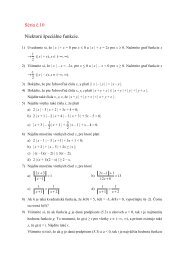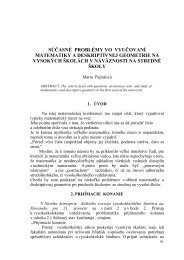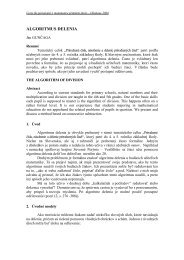- Page 3 and 4:
TEACHING MATHEMATICS II:INNOVATION,
- Page 5 and 6:
Scientific IssuesCatholic Universit
- Page 7 and 8:
CONTENTSBillich Martin. Zobrazenia
- Page 9:
PREFACEThe greatest challenge in wr
- Page 12 and 13:
10 Martin BillichV práci [3] Jung
- Page 14 and 15:
12 Martin Billich(a) Int S i ∩Int
- Page 16 and 17:
14 Jaroslava BrinckováKombinatoric
- Page 18 and 19:
16 Jaroslava Brincková4. Pre žiak
- Page 20 and 21:
18 Jaroslava Brinckovájúceho št
- Page 22 and 23:
20 Ján Gunčaga- vyučovanie matem
- Page 24 and 25:
22 Ján Gunčaga3. Teória Zoltána
- Page 26 and 27:
24 Ján Gunčaga5. SymbolizovanieV
- Page 28 and 29:
26 Ján GunčagaZ hľadiska vzťahu
- Page 30 and 31:
28 Ján Gunčaga7. učiť žiakov d
- Page 33 and 34:
Catholic University in RužomberokS
- Page 35 and 36:
Popis výskumu zameraného na vyuč
- Page 37 and 38:
Popis výskumu zameraného na vyuč
- Page 39 and 40:
Popis výskumu zameraného na vyuč
- Page 41 and 42:
Popis výskumu zameraného na vyuč
- Page 43:
Popis výskumu zameraného na vyuč
- Page 46 and 47:
44 Marika Kafkovábyly, jsou a ješ
- Page 48 and 49:
46 Marika Kafkovánikdy nedostane z
- Page 50 and 51:
48 Marika Kafkovánedala řešit ji
- Page 52 and 53:
50 Mária Kolkovápokusu. Veľa ča
- Page 54 and 55:
52 Mária KolkováObrázok 1 - Rie
- Page 56 and 57:
54 Mária Kolková3. Vzťah medzi s
- Page 58 and 59:
56 Mária Kolkováže riešenie Cez
- Page 61:
Catholic University in RužomberokS
- Page 64 and 65:
62 Jan Kopka, Leonard Frobisher, Ge
- Page 66 and 67:
64 Jan Kopka, Leonard Frobisher, Ge
- Page 68 and 69:
66 Jan Kopka, Leonard Frobisher, Ge
- Page 70 and 71:
68 Jan Kopka, Leonard Frobisher, Ge
- Page 72 and 73:
70 Lilla Koreňováštyroch triedac
- Page 74 and 75:
72 Lilla KoreňováOdborníci odhad
- Page 76 and 77:
74 Lilla KoreňováÚloha 5. Aké r
- Page 78 and 79:
76 Lilla Koreňová1. Určite áno2
- Page 80 and 81:
78 Lilla Koreňová1. Určite áno2
- Page 83 and 84:
Catholic University in RužomberokS
- Page 85 and 86:
CommentsOn J-conic sections 83We to
- Page 87 and 88:
On J-conic sections 85Figure 2. The
- Page 89 and 90:
On J-conic sections 87Preparing a c
- Page 91 and 92:
Catholic University in RužomberokS
- Page 93 and 94:
Refleksje nad wykorzystywaniem wied
- Page 95 and 96:
Refleksje nad wykorzystywaniem wied
- Page 97 and 98:
Refleksje nad wykorzystywaniem wied
- Page 99 and 100:
Refleksje nad wykorzystywaniem wied
- Page 101 and 102:
Refleksje nad wykorzystywaniem wied
- Page 103 and 104:
Catholic University in RužomberokS
- Page 105 and 106:
Losowe gry hazardowe a proces decyz
- Page 107 and 108:
Losowe gry hazardowe a proces decyz
- Page 109 and 110:
Losowe gry hazardowe a proces decyz
- Page 111 and 112:
Losowe gry hazardowe a proces decyz
- Page 113 and 114: Losowe gry hazardowe a proces decyz
- Page 115: ZakończenieLosowe gry hazardowe a
- Page 118 and 119: 116 Daša Palenčárová2. Implicit
- Page 120 and 121: 118 Daša PalenčárováÚloha 1 (s
- Page 122 and 123: 120 Daša PalenčárováNajčastej
- Page 125 and 126: Catholic University in RužomberokS
- Page 127 and 128: Premena interaktívnej tabule z hra
- Page 129 and 130: Premena interaktívnej tabule z hra
- Page 131 and 132: Premena interaktívnej tabule z hra
- Page 133 and 134: Catholic University in RužomberokS
- Page 135 and 136: Vedomosti študentov zo štatistiky
- Page 137 and 138: Vedomosti študentov zo štatistiky
- Page 139 and 140: Vedomosti študentov zo štatistiky
- Page 141 and 142: Vedomosti študentov zo štatistiky
- Page 143 and 144: Catholic University in RužomberokS
- Page 145 and 146: Kľúčové kompetencie a diskrétn
- Page 147 and 148: Kľúčové kompetencie a diskrétn
- Page 149 and 150: Kľúčové kompetencie a diskrétn
- Page 151 and 152: Catholic University in RužomberokS
- Page 153 and 154: Examples of introducing chosen conc
- Page 155 and 156: Examples of introducing chosen conc
- Page 157 and 158: Catholic University in RužomberokS
- Page 159 and 160: Examples of using ICT for forming r
- Page 161 and 162: Examples of using ICT for forming r
- Page 163: Examples of using ICT for forming r
- Page 167 and 168: Tvorba školského vzdelávacieho p
- Page 169 and 170: Catholic University in RužomberokS
- Page 171 and 172: Language Aspects of the Initial Pha
- Page 173: Language Aspects of the Initial Pha
- Page 176 and 177: 174 Takács István Árpád• What
- Page 178 and 179: 176 Takács István ÁrpádAsk the
- Page 180 and 181: 178 Takács István Árpád3. Concl
- Page 182 and 183: 180 Štefan TkačikDemokritos rozvi
- Page 184 and 185: 182 Štefan Tkačik2. Eudoxova exha
- Page 186 and 187: 184 Štefan Tkačikhranoly. Ostanú
- Page 188 and 189: 186 Štefan TkačikPre každé čí
- Page 190 and 191: 188 Štefan TkačikDefinícia 1. Fu
- Page 192 and 193: 190 Štefan TkačikArchimedov integ
- Page 194 and 195: 192 Erika TomkováAk PS chváli, mi
- Page 196 and 197: 194 Erika TomkováPrednosťou vytvo
- Page 198 and 199: 196 Erika Tomkováré, keď pri jed
- Page 200 and 201: 198 Erika Tomková[8] JODAS, V.: Ob
- Page 202 and 203: 200 Peter Vankúš, Emília Kubicov
- Page 204 and 205: 202 Peter Vankúš, Emília Kubicov
- Page 206 and 207: 204 Peter Vankúš, Emília Kubicov
- Page 208 and 209: 206 Peter Vankúš, Emília Kubicov
- Page 210: 208 Peter Vankúš, Emília Kubicov




